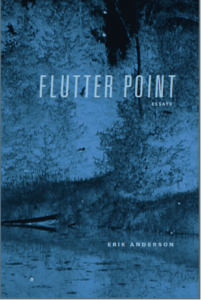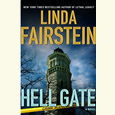Begin Again
Erik Anderson’s hybrid essays illuminate the cyclic movements in our environments and our minds
It’s tempting to begin a review of Erik Anderson’s Flutter Point by defining the term in the collection’s title essay. Maybe not the most original beginning, but I was (mostly) confident I could proceed from there with some insight. I’d planned to begin like this: “In ‘Flutter Point (An Essay in Three Acts)’ Anderson writes about the collapse of the Tacoma Narrows Bridge in 1940, just a few months after it was built. The collapse was caused by flutter, which Anderson defines as ‘the technical term for oscillation in the structure brought about by the wind but aggravated by the design, which caught the force instead of allowing it to pass through. Tacoma Narrows became a textbook example of how not to build a bridge, but the phenomenon also had other iterations.’”
 I was going to point out that in many ways Flutter Point is both an exploration of those other phenomena and also an iteration of a flutter point in textual form, daring the reader to pass through its architecture of unconventionally structured essays.
I was going to point out that in many ways Flutter Point is both an exploration of those other phenomena and also an iteration of a flutter point in textual form, daring the reader to pass through its architecture of unconventionally structured essays.
“Certified Copies,” for example, takes on the form of a scientific paper as it investigates questions of beauty (and also IKEA furniture) through sections titled “stating the question,” “materials,” hypothesis” and “results.” In “Letters From Lancaster,” Anderson refers to himself in third person only as “the subject,” while photographs of condemned properties and one-way street signs hover on the page like something out of W.G. Sebald. “Boomtown, USA” does not even begin with a complete sentence but extensions of the word boom. “Boom barrier. Boom, Belgium. Boom boat. Boom box. Boom brace. Boom burg.”
And, of course, “Flutter Point (An Essay in Three Acts)” is not just broken up into three acts but also includes an intermission. Are these structures catching some unseen force, or allowing a force to pass through them? Whether these essays are on the verge of collapse or not was never the question I found myself asking. Instead I was caught up in watching the oscillation of Anderson’s mind on the page.
Well, anyway, that was the plan for this review. Then I found myself returning to Anderson’s essay “The Blankness of Blankness,” which begins, “The first paragraph of this essay is imaginary. It does not exist.” After another false start, what follows are sections titled “Begin Again,” “And Again,” and “The Last Beginning.”
I am sometimes a little wary when a writer feels compelled to insist that something on the page is not a gimmick, but I quickly forgot this wariness thanks to Anderson’s often surprising language. Although these essays have varied forms and concerns, there is a kind of unity to be found in the probing, rhythmic power of his words. In “Anything Other Than Everything,” Anderson notes, “Where other endeavors suppress the voice, writing revels in it and in the empathy and antipathy it allows.”
 The strength of the voice in these essays made me more cognizant of my own writing process as a constant play of fits and starts. Why shouldn’t I admit that after I wrote a beginning to this review, I put the document aside for a while and returned to it on an unseasonably warm March day? Should I admit, too, that on that same day I read about how peak cherry-blossom season in Washington is forecast to fall on the earliest date on record, and suddenly wanted to focus this review almost solely on Flutter Point’s concern with science and the environment? One of my favorite essays in the collection, “The Rise of Slime,” discusses jellyfish, dying in one form and living on in another. Why didn’t I begin my review by talking about jellyfish? A person has only so many opportunities to begin with jellyfish.
The strength of the voice in these essays made me more cognizant of my own writing process as a constant play of fits and starts. Why shouldn’t I admit that after I wrote a beginning to this review, I put the document aside for a while and returned to it on an unseasonably warm March day? Should I admit, too, that on that same day I read about how peak cherry-blossom season in Washington is forecast to fall on the earliest date on record, and suddenly wanted to focus this review almost solely on Flutter Point’s concern with science and the environment? One of my favorite essays in the collection, “The Rise of Slime,” discusses jellyfish, dying in one form and living on in another. Why didn’t I begin my review by talking about jellyfish? A person has only so many opportunities to begin with jellyfish.
When Flutter Point is operating at its best, it has the potential to awaken readers not just to the big and small cyclical movements in the environment (“Nature abhors a straight line,” according to Anderson’s opening essay), but in their own minds, too. Neither the environment nor our minds are immune to collapse. “There are points in every system, even the psyche, when a disturbance becomes so acute that the whole thing starts to wobble and shake, when collapse first becomes possible and then inevitable,” Anderson writes in “Flutter Point.”
In the final essay in this collection, “Tigers Above, Tigers Below,” Anderson interweaves an ongoing game of Words With Friends with the narrative of his own writing and career path. Near the end of the essay, he relates a story told by the Buddhist teacher Pema Chödrön: A woman, chased by tigers, uses a vine to descend a cliff. Then she notices that tigers are waiting at the bottom of the cliff, too, and that a mouse is chewing on the vine. “She then notices a tiny patch of strawberries growing on the mountainside,” Anderson writes. “Tigers above, tigers below, she’s nonetheless delighted. She reaches out. The fruit is pulpy and sweet.”
There are plenty of tigers around us right now. Anderson seems to be asking us to stay there in the moment with those tigers, to pause to recognize all the strains and multitudes of forms that exist with us here in the present, even if a sense of collapse looms. By the end of Flutter Point, I was more aware that I was in a constant state of beginning and that the question I needed to ask wasn’t necessarily, “How to begin?” but something closer to, “How to begin this time? What do we choose to reach out for now?”

Lee Conell’s fiction has won the Chicago Tribune’s Nelson Algren Award and appeared in places like Kenyon Review, Guernica, Glimmer Train, and American Short Fiction. She earned her M.F.A. at Vanderbilt University, and her debut story collection, Subcortical will be published in November 2017 by the Johns Hopkins University Press. She lives in Nashville.


